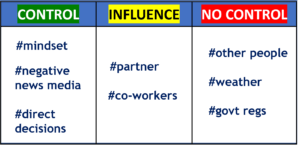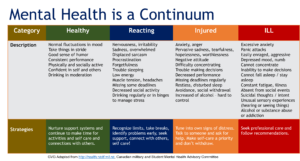
The challenges of the last several years have left many organizations creating company led mental well-being strategies and programs. However, the challenge continues.
Team members and organizations alike are facing increases in mental health issues such as depression, anxiety and substance abuse. A large employer survey from the Business Group on Health showed that 44% of employers saw an increase in these concerns in 2022 and that number rose to 77% in 2023. Also, 16% of employers expect that number to continue to rise in the future.
So what CAN we do?
Mental health challenges for employees were already on the rise before the pandemic. Many progressive organizations were already bringing in more mental health and wellness support. However, new programs only touch the tip of the proverbial iceberg. Mental well-being and inclusion are things we need to work on collectively together, both inside and outside of work.
With that in mind, here are a few action oriented “go to” strategies for mental well-being that we can use for ourselves and our teams.
1) Use a Continuum to Promote Inclusion and Neurodiversity
Overcoming the stigma of mental health in the workplace is not just about showing compassion for those struggling. It is about changing the conversation. Mental well-being is something we all need. Whether it spans from ways to reduce chronic stress and build adaptability to substance use disorder, part of the human condition is how we manage our mental health. It is part of our neurodiversity, just like personality differences.
Research around the mind and body connection also ties mental well-being directly to our physical wellness making this a true medical issue. Mental health also considered an inclusion discussion along with race, gender, age, disabilities and culture, and understanding that mental health is a continuum helps with these discussions.
Working together we can discuss how each person needs their own individual solution for mental health needs. Some people need time to get support from a professional and others need time for exercise to maintain a positive attitude. It’s all important and all necessary, and unique to the individual. Just remember not to minimize the needs of those with serious mental illness. Their solutions and level of support may be very different from those who are in “healthy maintenance” mode. The key is to make it safe to talk about and accept that people are in different categories and not judge others based on their current continuum placement. Remember, we all can move around this continuum and tomorrow you might be in a different place as well!
2) Identify Areas of Control and No Control
Lack of information and uncertainty creates compounded stress and anxiety for many people. Gallup’s 2024 trends report shows that employee stress is still on the rise and a survey of employees showed a high fear of job loss in 2024. So how can we help ourselves and our teams to deal with these worries?
Sometimes it helps just to get everything out of our head that is causing us concern.
Write everything you are worried about or feel overwhelmed by on a sticky note (real or virtual, one note per item). Using two sheets of flip chart paper (on a wall or virtually), label them “control” and “no control”. For each sticky, determine whether or not you personally can control it and then place it into the correct category of “control” or “no control”. By the way – this works great in a conference room with your team!
Then, look at the “no control” bucket. For each “no control” item, determine if you can influence it. Create a third sheet called “influence” for those items and move them over.

Now anything still left in the “no control” list requires us to do an Elsa (queue “Frozen” music) and “LET IT GO!” Tear them up, burn them, delete them and find a way to get them out of your circle of concern. They are taking up valuable real estate in your brain. Don’t give them space to live rent free!
Next, create a plan for those areas you CAN control and influence, instead of focusing on those you cannot. Focusing on only things we can control or influence helps relieve overwhelm and is a much better use of our time and energy!
3) Don’t just DO – Also UNDO Destructive Reward Systems and Practices
Celebrating long hours and exhaustion for “heroic effort” is a destructive mindset for mental well-being in the workplace, though we see this behavior getting rewarded all the time. In a psychologically safe environment, we use the analogy of an athlete instead of a heroic figure. The athlete requires rest, recovery and mental well-being for peak performance. So should we. Are we rewarding fire fighter behavior that burns people out or rewarding and holding up that person who is proactive about their boundaries (including fire prevention) and taking time to recover so they can show up 100% engaged when they are at work? Are we acknowledging time and effort or results and outcomes?
Make a list of why and when you give kudos and recognition. What behaviors is your organization supporting and re-enforcing? What would happen if you lifted up examples of people who show strength in dealing with their mental well-being and challenges or ran a “100% unplugged vacation” challenge? Do your processes and practices encourage long hours and reactive, crazy work? What can you change? In many organizations, UNDOING some practices and mindsets can be more important than adding more programs. What practices could go away today to help mental health for you and your teams?
4) Connection is Key to Mental Well-being AND Inclusion
At the end of the day, much of the research around mental well-being points directly back to personal connections. Whether it is the on-going research from Great Place to Work that says people with friends at work are more engaged or the experts who tell us inclusion is based on interpersonal relationships not just systems and slogans, connection is a key component of mental well-being.
We are wired for connection as a species. And without it, our mental health degrades quickly. So create a plan for how to connect with others just for the sake of connecting, with no agenda. Who gives you positive energy and vibes? Or better yet, who can YOU give positive energy and vibes to? Reach out, have coffee (virtual or IRL) or go for a walk together. You may be surprised at how much better you feel!
Looking for additional leader support? Reach out!





